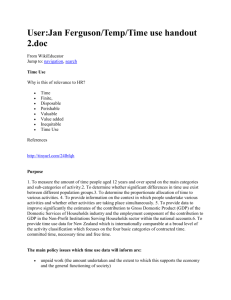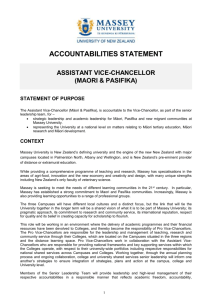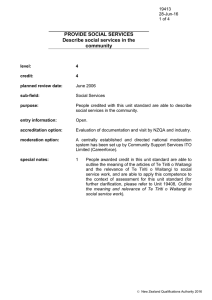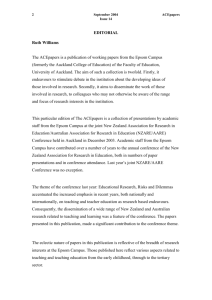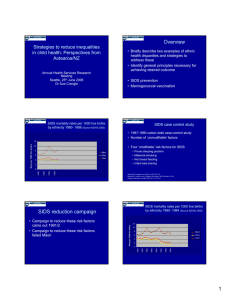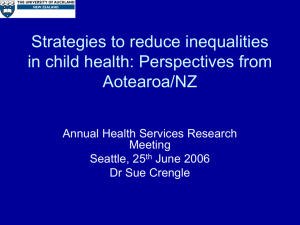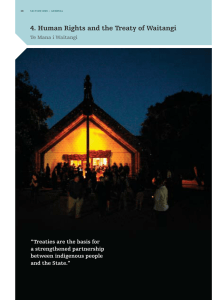Glossary Review author
advertisement
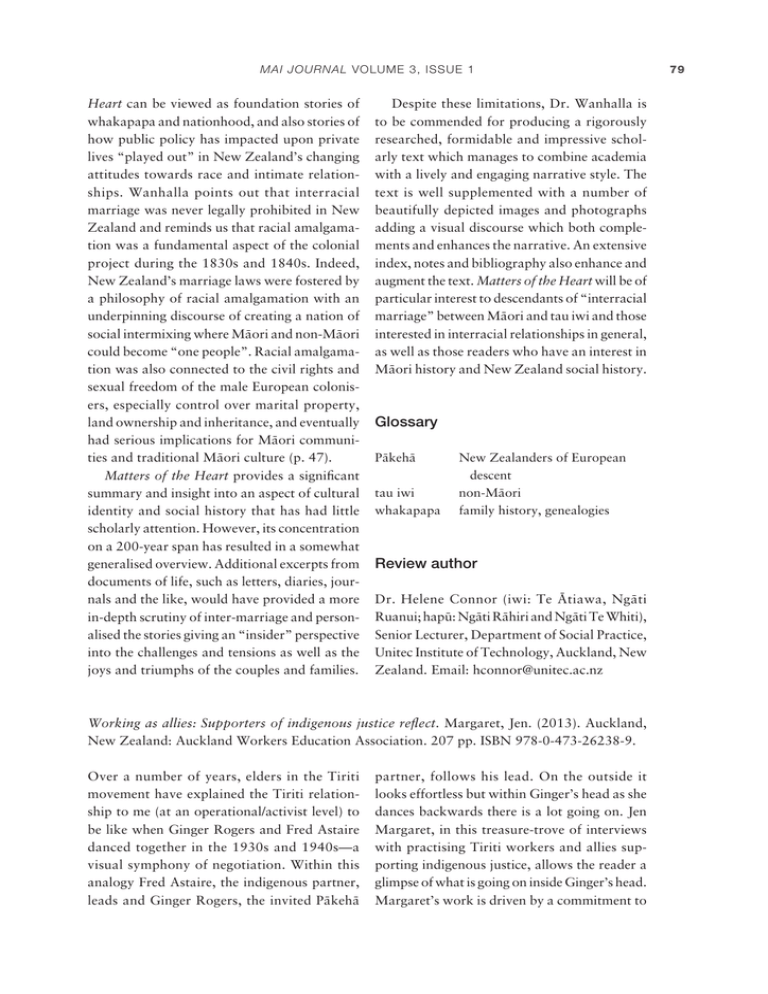
MAI JOURNAL VOLUME 3, ISSUE 1 Heart can be viewed as foundation stories of whakapapa and nationhood, and also stories of how public policy has impacted upon private lives “played out” in New Zealand’s changing attitudes towards race and intimate relationships. Wanhalla points out that interracial marriage was never legally prohibited in New Zealand and reminds us that racial amalgamation was a fundamental aspect of the colonial project during the 1830s and 1840s. Indeed, New Zealand’s marriage laws were fostered by a philosophy of racial amalgamation with an underpinning discourse of creating a nation of social intermixing where Mäori and non-Mäori could become “one people”. Racial amalgamation was also connected to the civil rights and sexual freedom of the male European colonisers, especially control over marital property, land ownership and inheritance, and eventually had serious implications for Mäori communities and traditional Mäori culture (p. 47). Matters of the Heart provides a significant summary and insight into an aspect of cultural identity and social history that has had little scholarly attention. However, its concentration on a 200-year span has resulted in a somewhat generalised overview. Additional excerpts from documents of life, such as letters, diaries, journals and the like, would have provided a more in-depth scrutiny of inter-marriage and personalised the stories giving an “insider” perspective into the challenges and tensions as well as the joys and triumphs of the couples and families. Despite these limitations, Dr. Wanhalla is to be commended for producing a rigorously researched, formidable and impressive scholarly text which manages to combine academia with a lively and engaging narrative style. The text is well supplemented with a number of beautifully depicted images and photographs adding a visual discourse which both complements and enhances the narrative. An extensive index, notes and bibliography also enhance and augment the text. Matters of the Heart will be of particular interest to descendants of “interracial marriage” between Mäori and tau iwi and those interested in interracial relationships in general, as well as those readers who have an interest in Mäori history and New Zealand social history. Glossary Päkehä tau iwi whakapapa New Zealanders of European descent non-Mäori family history, genealogies Review author Dr. Helene Connor (iwi: Te Ätiawa, Ngäti Ruanui; hapü: Ngäti Rähiri and Ngäti Te Whiti), Senior Lecturer, Department of Social Practice, Unitec Institute of Technology, Auckland, New Zealand. Email: hconnor@unitec.ac.nz Working as allies: Supporters of indigenous justice reflect. Margaret, Jen. (2013). Auckland, New Zealand: Auckland Workers Education Association. 207 pp. ISBN 978-0-473-26238-9. Over a number of years, elders in the Tiriti movement have explained the Tiriti relationship to me (at an operational/activist level) to be like when Ginger Rogers and Fred Astaire danced together in the 1930s and 1940s—a visual symphony of negotiation. Within this analogy Fred Astaire, the indigenous partner, leads and Ginger Rogers, the invited Päkehä partner, follows his lead. On the outside it looks effortless but within Ginger’s head as she dances backwards there is a lot going on. Jen Margaret, in this treasure-trove of interviews with practising Tiriti workers and allies supporting indigenous justice, allows the reader a glimpse of what is going on inside Ginger’s head. Margaret’s work is driven by a commitment to 79 80 MAI JOURNAL VOLUME 3, ISSUE 1 enhancing existing Päkehä dance moves and to supporting Päkehä to develop new levels of understanding of what it means to be Ginger, and I think this book will help consolidate and extend many readers’ dance moves. Informed by her master’s research (Margaret, 2009) and subsequent work carried out while on a Winston Churchill Scholarship trip (Margaret, 2010) to North America to examine anti-racism praxis, Margaret’s work has evolved over time, nurtured by well-chosen mentors. Margaret, like Huygens (2007) before her, is positioning herself as an insider commentator of the Päkehä Tiriti movement. Within this collection Margaret showcases allies working for indigenous justice from both sides of the Tasman, drawing out subtle variations in practice due to the geographic specificity of colonisation and institutional racism. From a New Zealand perspective the book contains interviews with Tim Howard, Alex Barnes, Melanie Nelson and the well-known movement matriarchs Joan McDonald and Mitzi Nairn. Howard, McDonald and Nairn provide a broad- brush introduction of the learning edges and challenges of being a Päkehä Tiriti worker, drawing on decades of experience. I felt Barnes and Nelson’s piece was the most powerful of the set, sharing the complexities of being Päkehä and being proficient in te reo Mäori. Their interview exposed the tensions and responsibilities that come with the (hardearned) gift of being bilingual within a dominant culture. Barnes and Nelson’s interview shows deep thinking about power dynamics and where and how they are accountable to Mäori. Their standpoint both within and outside the Päkehä world uniquely positions them to guide and support Päkehä attempts to be effective supporters of indigenous justice. I welcome their insights and unfolding leadership that can only strengthen the movement. Across the work Margaret has identified key themes pertaining to solidarity work that could potentially apply in a range of different social justice contexts. The themes include the need to address power imbalances, the ignorance of the (dominant) white settler population and the tendency to descend into analysis paralysis. Other themes include the challenge of working cross-culturally, which includes building and maintaining trust, respecting difference and managing conflicting expectations and the divergent interests of indigenous communities. Within the book, allies disclosed their struggles to find the line between working with Päkehä communities and maintaining relationships with allies. There was an uncomfortable tendency of allies to judge one another and patterns of many allies making their commitment to supporting indigenous struggles a lifetime one. Margaret captures the complexity of being Ginger Rogers—her loyalty, her creativity, her passion, her stubbornness and her learning edges. Many Päkehä Tiriti workers will recognise the dilemmas, challenges and rewards generously shared by her interviewees. I found this book to be a challenge to the Päkehä Tiriti movement to continue to have the courage to record our stories and our process so we can learn from the past, and if we must make mistakes, to let them be new ones. This review has presented a perspective grounded in a New Zealand context, but I wish to acknowledge that the scope of Margaret’s work is beyond these shores, addressing the experiences of activists in Australia and before that in North America. I am pleased and proud that people on the other side of the world have access to these rich stories. As a teacher, step one for me of integrating the learning of this book into my practice is to embed it into the curriculum when I teach community development. As a result of reading this book I plan on winding back my teaching of empowerment and focusing more carefully and deliberately on relationships, communication, negotiation, trust and respect. I hope this shift of focus will help produce more resourceful and useful community workers. Although other work has been published internationally on working as allies, what MAI JOURNAL VOLUME 3, ISSUE 1 makes this book unique is its antipodean focus. Margaret has developed a useful activist scholar text that is an exemplar of reflective practice. May it find its way onto many reading lists and may Margaret be swamped with invitations to share the learnings from this research. Glossary Päkehä settler; New Zealander of European descent te reo Mäori the Mäori language Tiriti Treaty, referring to Te Tiriti o Waitangi—the Mäori text of the 1840 Treaty of Waitangi Retrieved from http://researchcommons.waikato.ac.nz/bitstream/handle/10289/2589/thesis. pdf?sequence=2 Margaret, J. (2009). Learning in social movements: Experiences in the Päkehä treaty workers’ movement (Master’s dissertation). University of Auckland, Auckland, New Zealand. Retrieved from http://www.awea.org.nz/sites/awea.org. nz/files/Learning%20in%20social%20movements%20-%20Experiences%20in%20the%20 Pakeha%20Treaty%20workers'%20movement%20Jen%20Margaret%202009.pdf Margaret, J. (2010). Working as allies: Winston Chur chill fellowship report. Retrieved from http://www.communitymatters.govt.nz/ vwluResources/WCMFReport10Margaret/$file/ WCMFReport10Margaret.pdf Review author References Huygens, I. (2007). Process of Pakeha change in response to the Treaty of Waitangi (Doctoral dissertation). Waikato University, Hamilton, New Zealand. Heather Came, Lecturer, Department of Public Health, Auckland University of Technology, Auckland, New Zealand. Email: heather. came@AUT.ac.nz Ara mai he tëtëkura—Visioning our futures: New and emerging pathways of Mäori academic leadership. Whitinui, P., Glover, M., & Hikuroa, D. (Eds.). (2013). Dunedin, New Zealand: Otago University Press. 174 pp. ISBN 978-1-877578-60-1. To be Mäori and to be emerging as a leader in the academy of Aotearoa New Zealand creates tensions that non-Mäori colleagues may not know of—in the more grounded communication of te ao Mäori, it takes guts. Contributing as indigenous academics in the academy requires a careful balancing act for Mäori, who live and work in two worlds with different kaupapa. For Mäori academics, simultaneously there are two languages—te reo Mäori and te reo Päkehä; two or more cultures—te ao Mäori and te ao Päkehä; two histories—one of the coloniser “winner” who decides what is valid knowledge, and one of the colonised “loser” (Smith, 1999); two hierarchies—the academy, where there are few Mäori, and whänau, hapü and iwi, where almost all are Mäori (Hall, p. 45). Perhaps the sharpest tension is between the academic individual as the most profitable economic unit of “economism” (Forster, p. 128), who contributes to the income of their employing institutions through the Performance Based Research Fund (PBRF), and their individual “quality category” as researchers, challenging the collective aspirations and identity of Mäori as the indigenous tangata whenua and kaitiaki of both the land and the taonga of ancient knowledge. From the complexity of these relationships the “voices” of 20 or more of our new and emerging academic leaders stand as pou and reference points for others, especially Mäori, in the academy. For Mäori “leadership potential is both an innate and experiential quality” and “good 81

